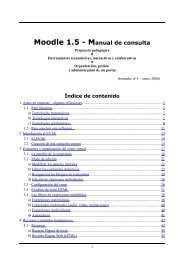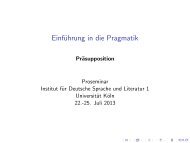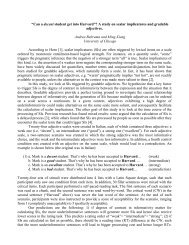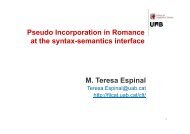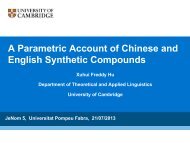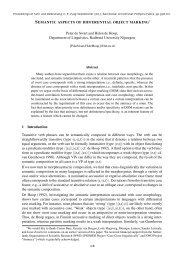Locating adpositions. - corpora@parles.upf
Locating adpositions. - corpora@parles.upf
Locating adpositions. - corpora@parles.upf
Create successful ePaper yourself
Turn your PDF publications into a flip-book with our unique Google optimized e-Paper software.
22<br />
Veronika Hegeds<br />
b. *ra a híd<br />
SUB the bridge<br />
‘onto the bridge’<br />
Moreover, their forms next to pronominal complements look the same as well. We have<br />
already seen in the examples in (9) that ‘dressed’ and ‘naked’ Ps behave differently, and it is<br />
the case marker in the complement of ‘naked’ Ps that is similar to ‘dressed’ Ps. What we can<br />
observe is that the pronominal form is created by adding an agreement suffix to the<br />
postposition / case marker. This is again illustrated in (14).<br />
(14) a. (én)mögött-em<br />
I behind.at-1sg<br />
‘behind me’<br />
b. (én)nál-am<br />
I ADE-1sg<br />
‘at me’<br />
‘Dressed’ Ps and case suffixes also exhibit the same structure in demonstrative constructions:<br />
both of them are ‘reduplicated’ on the demonstrative pronoun, as illustrated in (15).<br />
(15) a. az alatt a híd alatt<br />
that under the bridge under<br />
‘under that bridge’<br />
b. az -on a híd-on<br />
that-SUP the bridge-SUP<br />
‘on that bridge’<br />
As is expected, in the case of ‘naked’ Ps, the oblique suffix reduplicates on the demonstrative,<br />
supporting further the view to take postpositional elements and case suffixes as instantiations<br />
of the same category, and to treat ‘naked’ Ps as different from the other two.<br />
(16) az - on a híd-on át<br />
that-SUP the bridge-SUP across<br />
‘across that bridge’<br />
Eventually, every syntactic account of PPs has to be able to deal with this phenomenon of P-<br />
reduplication on the demonstrative, but this is beyond the scope of this paper. What these<br />
examples are meant to emphasize is that when it comes to syntactic properties, postpositions<br />
and case suffixes behave very much alike. This gives an additional argument for treating these<br />
two on a par, and not ‘dressed’ and ‘naked’ Ps, since ‘naked’ Ps show none of these<br />
properties but share properties with particles. I will turn to these elements now.<br />
3.3. Postpositions and particles<br />
Many of the particles in Hungarian are spatial, but some of them seem to have lost their<br />
original spatial meaning and now function purely as telicizers (Kiefer 1992). Spatial particles




